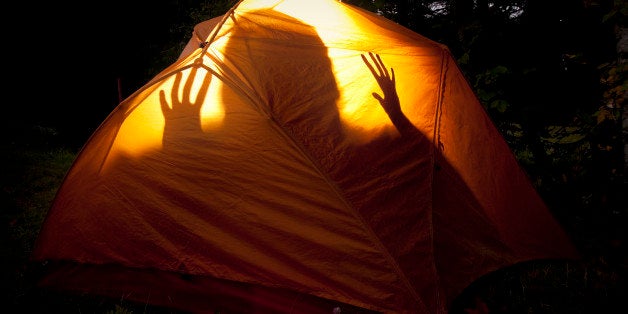
The terror generated by a ghost story can be more lasting than the shocks delivered in a horror story... indeed, this different quality of scariness may be what distinguishes one form from the other, not the simpler question of whether or not a ghost features. Freddy Krueger is, technically, a ghost, but the "Nightmare on Elm Street" films are horror -- indeed, as Freddy becomes more familiar, he enters the pantheon of movie monsters, which has surprisingly little room for ghosts. "The Blair Witch Project," in contrast, is a ghost story, though it barely mentions ghosts -- instead, it's marked as a ghost story by its ambiguity, its sense of a presence affecting the characters, and the care taken to sketch out the history of the haunted woods.
Horror makes you jump, and -- sometimes -- makes you think. Ghost stories slowly lower your body temperature, producing the frisson effects described as chills down your spine or goose-flesh. Sometimes, they make you stop thinking because what they are suggesting is too awful to contemplate ...and the physical response takes over. Ghost stories offer the sort of scares which come back to you when you wake up in the middle of the night. "The Sixth Sense" just missed this list, because its ghosts aren't ultimately frightening, but M. Night Shyamalan includes a great scare moment as his child hero gets up to take a pee in the middle of the night and encounters a pleading specter. Everyone who saw that film had total recall of that moment the very next time they made their way through a darkened home to the bathroom.
My latest novel, An English Ghost Story (October 7, $14.95), is an exploration of what its title means just as it's an exploration of a haunted house -- its shifting topography and its long history. This list is about ghosts, rather than haunted places -- though spirits are often tied to specific locations. And I've chosen stories which got under my skin, and have stuck with me.
I've looked at various media, but find that often the best ghosts transfer from one realm to the other, moving from the printed page to a screen:
"Oh, Whistle and I'll Come to You, My Lad"
A short story by M.R. James, adapted into a television film ("Whistle and I'll Come to You") by Jonathan Miller in 1968. The spectre which manifests after a holidaying professor finds and blows an antique whistle is a reverse joke -- James takes the most debased, cartoonish, your-kids-dressed-up-for-Halloween image of the ghost (a sheet with eye-holes) and presents it with deadly seriousness ('a face of crumpled linen'). My father remembers a BBC wireless version of the story (hosted by Valentine Dyall as the Man in Black, on "Appointment With Fear") in the 1940s which made him terrified of the dressing gown hanging on his bedroom door.
"How Love Came to Professor Guildea"
A novella by Robert Hichens, published in Tongues of Conscience (1900). This is the least-known of my choices, though an Internet search reveals it was adapted as an episode of the early TV horror series "Lights Out" in 1950 ... and has been done several times on the radio (here's a 1948 version from the show "Escape"). M.R. James abided by a set of rules for the ghost story, including the tenet that the ghost must be malevolent and capable of harming the living... Hichens found a subtler, more unsettling approach as a repressed bachelor academic attracts a formless, imbecilic lump of a ghost which fixates on him like an unwelcome lover.
"The Haunting"
Shirley Jackson's 1959 novel The Haunting of Hill House was filmed by Robert Wise as "The Haunting" in 1963. In keeping with the novel's ambiguity, Wise shows no onscreen ghosts but powerfully conveys the effects of their presence... the loud breathing that bows a huge wooden door is unsettling, though the most well-remembered chill is a neat contrivance as the troubled Eleanor (Julie Harris) is terrified at night and reaches out to hold the hand of her roommate Theo (Claire Bloom). The camera closes on Harris's face as she is comforted by her friend's firm grip... then a cut shows that Theo isn't in the bed but is all the way across the room. 'Whose hand was I holding?'
"Dead of Night: The Exorcism"
I could have filled this list with television ghost stories from the 1970s ... the annual BBC M.R. James adaptation in the "Ghost Story for Christmas" series, one-off plays like Nigel Kneale's "The Stone Tape" and John Bowen's "A Photograph," children's serials like "The Owl Service," American TV movies like "Something Evil" and "Don't Be Afraid of the Dark," episodes of "Night Gallery," "Supernatural" and "Shadows." This play by Don Taylor, broadcast in 1972, is the one that most terrified me then, and most haunts me to this day (it's included in the BFI's DVD release of "Dead of Night"). Four middle-class friends have dinner in a converted farmhouse where a family once starved to death, and are trapped in a replay of the tragedy.
"The Shining"
Stephen King's novel, controversially filmed by Stanley Kubrick in 1980. The ghost of the Overlook Hotel who most stays in my mind is Delbert Grady (Philip Stone), the deferential waiter who spills avocat on Jack (Jack Nicholson) and takes him into the disturbingly red-and-blue men's room to mop him off and give him instructions to deal with his family and interlopers. Grady at first claims to have no memory of chopping his own family to bits, but then coldly recalls "correcting them." The scene is framed and edited to keep Grady in profile and long shot until he turns menacing, then a cut to a medium shot allows Stone -- a genial you-know-the-face character actor -- to flash the most blankly terrifying expression in the cinema.
"Twin Peaks: Fire Walk With Me"
David Lynch doesn't exactly make ghost stories, but his films are full of terrifying apparitions in human form -- the kabuki-faced Dean Stockwell miming to "In Dreams" in "Blue Velvet," Robert Blake as the bilocating Mystery Man in "Lost Highway," the medusa-staring vagrant round the corner from a restaurant in "Mulholland Dr.," the huge-eyed gurning Laura Dern doppelganger of "Inland Empire." However, his most appalling specter is Bob (Frank Silva), the demon of Twin Peaks who appears to doomed Laura Palmer, possessing her father and eventually taking on her identity. Silva was a technician accidentally caught on camera while Lynch was filming the TV show, and stayed on to be the incarnation of all the ills of the multiverse. His most frightening moments come in Lynch's film prequel, as we see how he permeates the last days of Laura's life.
Ringu/"Ring"/"The Ring"
Sadako in Koji Suzuki's novel and the Japanese film series, but Samara in the American remakes, the vengeful spirit of "Ring" crawls out of a well and the television set one week after a victim has looked at a cursed videotape. She brings death, but that's almost not the point... the various versions of the story have given her varying backstories (in the novel and a Korean film, she's not even a her but a hermaphrodite), but the indelible moment for Sadako's presence in pop culture, which familiarity and parody haven't dulled, is the simple image of the lank-haired, contortionist ghost coming through the screen at her next victim.
"Ghost Stories"
Theatre is an underappreciated medium for scares ... there's something unique about gasping or clutching the nearest arm at something which is really happening (in a manner of speaking) in the same room as you. The Woman in Black has been running for years on the strength of its chill. I was part of a group who put together our own spook play, The Hallowe'en Sessions, in 2012. Andy Nyman and Jeremy Dyson's play Ghost Stories, still enjoying its second successful West End run, is a thoughtful analysis of what ghost stories are and what they might mean... but what audiences take away is that first glimpse of a white-faced, red-dressed mannequin which moves when it shouldn't.
